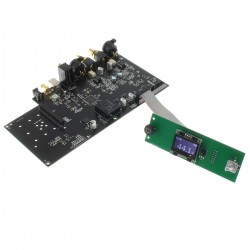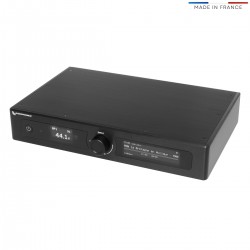New Customer?
Create your accountNo products
Prices are tax included
New installation system for EVO Sabre under Volumio (plugin)
EVO Sabre Volumio plugin Beta Test
We are currently porting our software to run Volumio on a EVO Sabre into the official Volumio plugin store.
This solution will allow users to install every bit of software needed for the EVO directly from Volumio regular Web Interface (no more SSH, no more custom OS image, no more display lost after an update..etc.). Basically this will be a huge upgrade regarding user experience as well as for maintenance purpose.
It will totally replace the customized images system / installation scripts. So overtime using this plugin will be the way to go.
This plugin is currently in beta test mode. You can help making it into the stable official Volumio plugin store by testing & providing feedback.
Installation procedure:
- 1. Download a fresh Volumio image and use it to install Volumio on your SD card.
- 2. Insert the SD card into your EVO Sabre.
- 3. Use a RJ45 cable to connect the device to your network (if you prefer to use WiFi instead, this walkthrough assumes that you already know how).
- 4. Power-on your EVO Sabre and wait a couple minutes for it to boot.
- 5. Connect to Volumio Web User Interface on the same network using a web browser or a phone with Volumio app installed.
- 6. Follow the initial Wizard configuration helper.
- a. You need a Volumio account to install plugins (a free one will work fine) so log into your account when asked or create a new one if you do not have any Volumio account yet.
- b. The Wizard configuration helper will also ask you for a I2S DAC. You should enable that option and select "Audiophonics I-Sabre ES9028Q2M" in the drop-down menu.
- c. If you forgot to do 6.a and 6.b during wizard configuration, you can find those option again in Settings → System → Run First Config Wizard.
- 7. Enable Plugin Test Mode (see video below):
- a. Go to http://volumio/dev (replace ‘volumio’ by the EVO Sabre IP on your network if you are using IPV4 as URL).
- b. Enable the option Plugins Test Mode.
- 8. Go back to the WebUi and open the Plugins Section.
- a. Look for the System Hardware Tab and install the plugin Audiophonics Evo Sabre.
- b. After installing enable the plugin from the Installed Plugins Tab.
- c. The remote still needs a reboot to be 100% working.
Testing the plugin:
Actually testing the plugin is quite straightforward: after installing the test plugin, just use your EVO Sabre as you would normally do in your everyday life. Just take notes to report anything that seems to be not working as expected. You are also welcome to share any observation regarding potential items that you found misleading or difficult to understand in the interface or documentation.
Next steps:
After the plugin beta life cycle this will be available in the regular Volumio Plugin store. This means step 7 in the procedure describe above will no longer be required.
Providing Feedback:
- If you notice anything wrong while using this plugin, please let us know in the dedicated thread.
- Positive feedback is fine too! If you found the plugin easy to install and found nothing troublesome while using this software, it will help the deployment process to know that successful user experiences also happened.
Rechercher dans le blog
Blog categories
Latest Comments
Audiophonics Team
on DIY Tutorial - PiCorePlayer - Installing...Pierre Bommel
on Lecteur réseau Opensource : SolutionsPierre Bommel
on DIY Tutorial - PiCorePlayer - Installing...Audiophonics Team
on Tutorial DIY - Power cable ELECAUDIO CS-331B

































17 Commentaires
Laisser un commentaireErika Zorat 2024-06-16
Audiophonics Team 2024-06-17
Regardless of the distribution used (Volumio, moOde, piCore), you can connect our Sabre DACs to the Pi using USB or I2S and set it as an audio output without installing anything.
The purpose of our plugins & source codes is to install additional hardware elements (I/R receiver, OLED display, power controller ) which are not needed at all for audio playback : you can definitely decide to skip them and customize the system as you see fit with other plugins and harware.
This is actually what we do for the RaspTouch on Volumio. You can follow this walkthrough : https://github.com/audiophonics/rasptouch_volumio3 (skip the section "Install the plugin Audiophonics ON/OFF" if you don't plan to use a power controller).
I suggest you checked if your display is supported beforehand (some can be too power-hungry for the Pi). Also depending on your display, the whole installation might require a bit of linux-flavored headaches to have the image fit the display and proper touchscreen calibration ( see https://community.volumio.com/t/plugin-touch-display/10647 )
Arnaud Freund 2024-01-16
est ce que ce plugin est stable ou toujours en version beta?
Qu'est ce que cela apporte avec l'evo-sabre?
Si j'ai bien compris, le fait de toujours avoir l'écran de droite activé malgré les mises à jour!
Mais est-ce que cela apporte une meilleure utilisation du evo-sabre au point de vu sonorité?
Merci d'avance pour votre retour
Audiophonics Team 2024-01-22
le plugin n'est plus en beta, mais cela reste de l'open source.
Aucune incidence sur le son. Le plugin ne gère que les interfaces auxiliaires (télécommande, écran de droite).
Si vous cherchez une intégration minimaliste vous pouvez faire l'impasse dessus sans remords.
Alain MASSON 2023-11-11
J'a acheté cet appareil en 2 temps. D'abord la carte et son petit écran, puis le boitier et l'écran large Oled2.
Tout fonctionne parfaitement mais je constate que l'écran large (à droite dans le boitier) possède un affichage terne manquant de luminosité (Par rapport au petit écran qui affiche la fréquence d'échantillonnage.
Est-ce normal ? (car j'ai vu des images de ces écrans ou les 2 ont une luminosité égale)
Merci
Audiophonics Team 2023-11-17
avez-vous configuré le contraste dans les options du plugin ?
Gerhard Kulzer 2023-10-10
evo_oled2.service - OLED Display Service for EVO SABRE
Loaded: loaded (/data/plugins/system_hardware/audiophonics_evo_sabre/service/evo_oled2.service; linked; vendor preset: enabled)
Active: active (running) since Tue 2023-10-10 13:29:29 CEST; 54s ago
Main PID: 3231 (sudo)
Tasks: 12 (limit: 4410)
CGroup: /system.slice/evo_oled2.service
├─3231 /usr/bin/sudo /usr/bin/node /data/plugins/system_hardware/audiophonics_evo_sabre/apps/evo_oled/index.js volumio
└─3232 /usr/bin/node /data/plugins/system_hardware/audiophonics_evo_sabre/apps/evo_oled/index.js volumio
Oct 10 13:29:29 audio systemd[1]: Started OLED Display Service for EVO SABRE.
Donc je suppose que le pb est lié au hardware. Pourtant j'ai controllé et re-controllé les deux connecteurs reliant le display.
Avez vous une idée?
Audiophonics Team 2023-10-11
J'ai déjà vu cela se produire sans que le hardware ne soit en cause, par exemple lorsqu'un autre plugin ou logiciel prend la main sur la section du GPIO utilisée par l'écran#2 avant le lancement du plugin.
Vous pouvez sûrement obtenir une erreur plus explicite via SSH en stoppant le service evo_oled2 et en exécutant directement la commande de lancement du pilote d'écran "/usr/bin/sudo /usr/bin/node /data/plugins/system_hardware/audiophonics_evo_sabre/apps/evo_oled/index.js volumio". La console devrait détailler ce qui ne va pas.
Stefan Huy 2023-10-09
I recently bought the AUDIOPHONICS EVO-SABRE Balanced DAC 2x ES9038Q2M Board. So far it works pretty good. Anyhow, I have some struggles with the DAC driver in Volumio. The instruction emntion to use the ES9028 driver in Volumio. This driver is not working, always resulting in ALSA error message. Now I use the HifiBerry DAC2 HD driver which works, but I'm not sure if it supports the full capability of the ES9038Q2M dual Mono implementation.
Which driver do you recommend to use?
Audiophonics Team 2023-10-10
This cannot be right. You should use our driver and this device cannot work with a DAC2 HD driver.
Please double check your configuration and contact directly our after sales service if you still have trouble.
Juan Pablo Garcia 2023-01-02
This information it used to be in the forum, but not anymore :(
I just want to get the most out of the DAC and I am not sure if using the ES9028 driver is the right way to use.
Thanks in advance.
Audiophonics Team 2023-01-06
Stéphane Gattoni 2022-10-15
L'installation s'est aussi bien passée de mon côté, merci pour la simplicité.
Par contre l'écran de gauche (le petit) n'affiche rien, je ne sais pas si c'est un problème matériel ou logiciel, y a-t-il un moyen de tester ?
Pour l'écran de droite, il y a des bugs d'affichage avec la lecture de Spotify (retour parfois à l'horloge), est-ce lié au plug-in de Spotify ?
Et dernière question pour l'extinction: si on fait une extinction "douce" dans Volumio, le DAC reste sous tension (et le voyant de veille ne s'allume pas). Y a-t-il un moyen d'éteindre complètement par cette procédure, ou faut-il de toute façon faire les 2 extinctions (logiciel puis hardware) ?
Merci beaucoup et bien cordialement,
Stéphane
Audiophonics Team 2022-10-24
Vous n'êtes pas le seul à avoir remarqué des bizarreries avec le plugin Spotify et j'y ai donc jeté un oeil.
Le plugin m'apparait déjà relativement instable en lui-même.
Mais même lorsque tout fonctionne sans accrocs, je remarque des occurrences où les données de lecture ne sont effectivement pas propagées aux clients (qu'il s'agisse de l'interface web ou de mon plugin) qui de facto ne sont pas au courant que de la musique est toujours en cours de lecture (d'où l'horloge).
Je regarde ce qu'il est possible de faire pour rétablir un comportement d'écran normal en de telles circonstances.
J'imagine que ce souci sera de toute façon réglé dans un futur patch du plugin Spotify, mais ça ne doit pas être bien compliqué de rajouter une petite couche de polling comme filet de sécurité au cas où l'API Spotify refait des siennes à l'avenir. Je ferai une update d'ici peu.
Pour l'écran de gauche, il embarque son propre firmware et doit afficher des choses dès lors que la board est alimentée (même sans Raspberry Pi monté).
A part vérifier le branchement et l'intégrité de la nappe, je vous suggère de demander conseil à notre SAV.
Thierry FRANSSEN 2022-10-13
Tout s'est bien passé à l'installation. Cependant, certaines touches de la télécommande (flèches droite/gauche pour passer au morceau suivant ou redémarrer le morceau en cours, flèches haut/bas, ainsi que la touche pause) ne fonctionnent plus.
Toutes les autres touches fonctionnent normalement.
Audiophonics Team 2022-10-13
Merci pour le retour.
Une fois le plugin installé le EVO doit redémarrer une fois pour que le système d'exploitation ne réagisse à la télécommande.
Les fonctions de base (volume / source) sont complètement indépendantes du logiciel utilisé et sont disponibles par défaut (même sans Raspberry Pi).
Si après un premier redémarrage, vous n'arrivez toujours pas à utiliser la télécommande, j'ai laissé une fonction de diagnostic dans la page de configuration de module. Consultez le bouton intitulé "vérifier statut télécommande".
Harald Lankisch 2022-10-07